

War Posters WW1. My Grandad Marches on ANZAC Day EDX 2170 assignment 1. My Grandad Marches on ANZAC DAY. Anzac Day Tribute to Pte Simpson and his Donkey. The Poppy Story (Early Years) Women in WWI. In the trenches of 1914-1918. Build your First World War school programme - Education - Auckland War Memorial Museum. One Hundred years on from the First World War: 2014 – 2018 We provide a wide range of educational opportunities to help engage students with the events of the First World War.

These include onsite educator led programmes, onsite independent programmes and gallery links, competitions and more. Education programmes (educator led) First World War. Origins The First World War was caused by the destabilisation of the balance of power in Europe due to the rise of Germany.
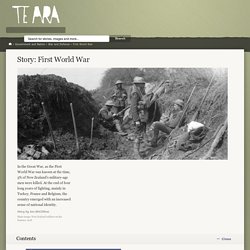
The war began in 1914 when Austria-Hungary invaded Serbia because of the assassination of an archduke. Countries had made alliances with each other, and soon most of Europe was at war. New Zealand was part of the British Empire, and when Britain declared war on Germany, in August 1914, that meant New Zealand was at war too.
The two sides were called the Central Powers (Germany, Austria-Hungary) and the Allies, which included the British Empire, Russia and France. WORLD WAR ONE TRENCH WARFARE. History of Anzac Day. Anzac Day 1916-22: The making of a holy day 25 April 1922 was a day of mourning throughout New Zealand.
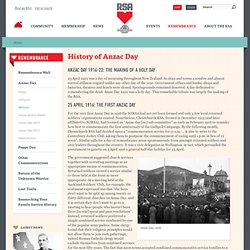
In cities and towns a sombre and almost surreal stillness reigned unlike any other day of the year. Government offices and banks, shops and factories, theatres and hotels were closed. Sportsgrounds remained deserted. A day dedicated to remembering the dead. Soldier & letter from home. How many New Zealanders served on Gallipoli? As the centenary of the First World War approaches, people are interested in how many Kiwis served in the various campaigns.

For Gallipoli, the answer is not straightforward – and the waters have been muddied by a mistake by a senior British general that went unnoticed for nearly a century. Sir Ian Hamilton was a respected military thinker but not a great success as head of the Mediterranean Expeditionary Force (MEF), the cobbled-together Allied army which began landing on Turkey’s Gallipoli Peninsula on 25 April 1915.
I’ve recently realised that Hamilton was also responsible for a significant underestimate of the number of men who served on Gallipoli in New Zealand units of the MEF. Sir Ian Standish Monteith Hamilton. Library of Congress, LC-DIG-ggbain-18025. New Zealand at War Timeline. Battle of Gallipoli - World War I. Remembering Gallipoli - Online on Pinterest. Poppy Field - Visualising War Fatalities.
The Gallipoli Catastrophe Documentary. Shop. The Battle Of Gallipoli. Rare Film Footage. YouTube. World War I in Photos: A Century Later. World War 1 in 6 Minutes. Timeline and graphic display of Allied deaths during and following WWI. The Gallipoli campaign - The Gallipoli campaign. Each year on Anzac Day, New Zealanders (and Australians) mark the anniversary of the Gallipoli landings of 25 April 1915.
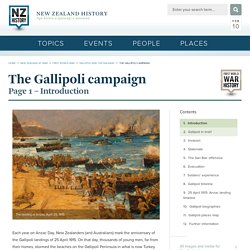
On that day, thousands of young men, far from their homes, stormed the beaches on the Gallipoli Peninsula in what is now Turkey. For eight long months, New Zealand troops, alongside those from Australia, Great Britain and Ireland, France, India, and Newfoundland battled harsh conditions and Ottoman forces desperately fighting to protect their homeland. By the time the campaign ended, more than 130,000 men had died: at least 87,000 Ottoman soldiers and 44,000 Allied soldiers, including more than 8700 Australians. World War One. Anzac Ted Video. List of hospital ships sunk in World War I.
During the First World War, many hospital ships were attacked, both on purpose or by mistaken identity.

They were sunk by either torpedo, mine or surface attack. They were easy as well as tragic targets, since they carried hundreds of wounded soldiers from the front lines. Background[edit] The ship should give medical assistance to wounded personnel of all nationalitiesThe ship must not be used for any military purposeShips must not interfere or hamper enemy combatant vesselsBelligerents as designated by the Hague Convention can search any hospital ship to investigate violations of the above restrictions If any of the restrictions were violated, the ship could be determined as an enemy combatant and be sunk. Hospital Ships sunk[edit] Notes[edit] Jump up ^ "Asturias" was beached near Bolt Head, but the damage was so extensive that she was declared a total loss. References[edit] WW100 New Zealand. World War One: The many battles faced by WW1's nurses.
Nursing in World War One was exhausting, often dangerous work and the women who volunteered experienced the horror of war firsthand, some paying the ultimate price.
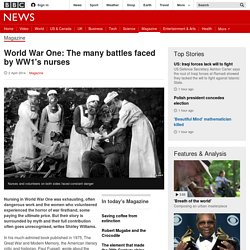
But their story is surrounded by myth and their full contribution often goes unrecognised, writes Shirley Williams. In his much-admired book published in 1975, The Great War and Modern Memory, the American literary critic and historian, Paul Fussell, wrote about the pervasive myths and legends of WW1, so powerful they became indistinguishable from fact in many minds. Surprisingly, Fussell hardly mentioned nurses. There is no reference to Edith Cavell, let alone Florence Nightingale. Yet the myth of the gentle young nurse, often a voluntary and untrained VAD (Voluntary Aid Detachment), in her starched and spotless white uniform, was universally admired.
Front Lines - Nurses at the Front. Google Image Result for. Anzac Trench. WW1 air force. Propaganda. The Anzac landing at Gallipoli. The Anzac landing: overview Why did theAnzacs land?
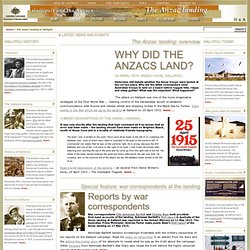
25 April 1915: Anzac Cove, Gallipoli Historians still debate whether the Anzac troops were landed at the correct place. Why did the Allied commanders send Australian troops to land on a beach before rugged hills, ridges and steep gullies? Image result for nurses during ww. Stretcher Bearers. Advancing troops were not allowed to stop and care for wounded soldiers.

All men carried an emergency field-dressing and if possible attempted to treat their own wounds. The wounded soldier then had to wait until the stretcher-bearers arrived. There were only four stretcher-bearers per company and so it was often sometime before they received medical help. Some dragged themselves into a shell-hole for protection, but this was dangerous as many sank into the mud and drowned. One man with a broken thigh spent two days dragging himself backwards with his hands, until he reached his own trenches. In good conditions two men could carry a wounded man on a stretcher. Paper Nurse hat. Image result for nurses during ww. Simpson and his donkey. New Horrible Histories Song - World War 1 Cousins - CBBC. World War One. E-ako maths. Women before and after ww1. Nurse posters in world war one. Encyclopedia Smithsonian: Cher Ami. Cher Ami (click to zoom) "Cher Ami" was a registered Black Check Cock carrier pigeon, one of 600 birds owned and flown by the U.S.

Army Signal Corps in France during World War I. He delivered 12 important messages within the American sector at Verdun, France. On his last mission, "Cher Ami," shot through the breast by enemy fire, managed to return to his loft.